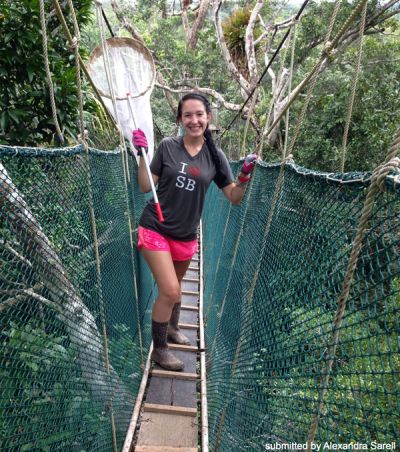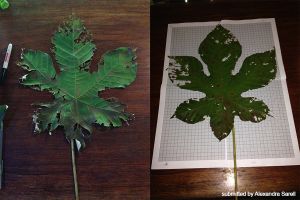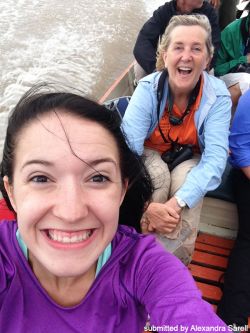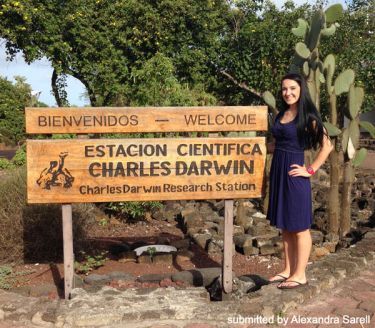
Alexandra Sarell collected insects in the longest canopy walkway in the world, spanning 1/4 mile. She traveled as high as 120 feet in the air on this walkway in the Amazon rainforest.
“As the last of the South American dirt is washed off of my rain boots on this dreary day, I am still in awe of everything that has captivated my every moment for the last month. My boots and I tromped through trails riddled with roots, leaf debris, and army ants in the heart of the Amazon, frolicked through the highlands of Floreana and Santa Cruz Islands in the Galapagos with giant tortoises, and soiled the floors of at least seven airports.”
While this may sound like the travel writing of a renowned scientist, it is actually the written words of Saint Mary-of-the-Woods College (SMWC) junior biology major, Alexandra Sarell, about her study abroad experience in the Amazon rainforest this past summer. And based on her commitment to the scientific research she conducted in the Amazon, she is sure to reach that aforementioned status some day.
Sarell, of South Bend, Ind., traveled to the Amazon with Margaret Lowman, Ph.D., or “Canopy Meg,” as she is fondly referred to by most in the field.
Thirty other people were a part of the expedition including: Rob Nelson, a biologist, filmmaker and director of Untamed Science, a company focused on the creation of media to encourage budding scientists; Michelle Trautwein, Ph.D.; and Megan Thoemmes.
The group traveled with Lowman to continue her research on insect-plant relationships through herbivory – the study of the amount of damage that a leaf sustains from insects.
“We measured 10,000 different leaves at the Amazon Conservatory of Tropical Studies (ACTS) Field Station in the heart of the jungle,” says Sarell. The process involved carefully tracing each leaf on graph paper to account for each missing piece as well as “mining,” or the burrowing and tunneling of insects in the leaf.

To study the amount of damage that a leaf sustains from insects, Sarell carefully traced Cecropia leaves on graph paper to account for each missing piece.
Sarell was responsible for the study of quick emerging trees and the damage their large leaves sustain. She specifically chose Cecropia trees because of their high level of mutualisms with ants, bees and termites.
“There were high levels of damage on each of my leaves, and they were, on average, about 380cm2, which is huge!” says Sarell. “The hypothesis was not conclusive, as we are only in the 20th year of data collection, and Meg is aiming for many more years of data collection.”
Additionally, Sarell assisted in the collection of organisms such as insects and mites for the other researchers on the expedition.
“I was so excited to wake up each day and see what was in store for me,” says Sarell. “It was a dream come true to even get to go, let alone get to wake up there every day and explore the world of field biology and the mysterious secrets of the Amazon and Galapagos.” And to think it all started when Sarell decided to attend a Four-Star Series presentation at SMWC.
Sarell attributes her success and amazing jumpstart in her career to the support she has received at The Woods.
“This place definitely has given me the confidence to be a courageous woman in science, which I don’t think I could get from any other college,” states Sarell. “At The Woods, there are many more opportunities to become a leader in science, as we are required to pilot our own research and write based on that work and later have the opportunity to publish it. I am excited to see what is next for me and how the Woods will help me to grow in the next two years as a leader and a scientist.”

Alexandra Sarell and Margaret “Meg” Lowman, Ph.D. rode a small, traditional motorboat along the Amazon in search of birds in the early morning.
When Sarell was a freshman, she attended the presentation by Lowman, a world-renowned rainforest canopy biologist who actively encourages the next generation of science.
“In her presentation, she discussed being a woman in science, and I was really inspired by her words,” explains Sarell. “I introduced myself afterward, and we talked for quite some time and exchanged contact information. I was fascinated by her past, and she was hopeful for my future. Inspired, we both began to email back and forth. She became my role model and mentor and has been a catalyst in my success as a science major.”
At the conclusion of Sarell’s Amazon experience, Lowman asked her to commit to a three-year research stay in order to help change the face of rainforest ecology.
“That alone is gratifying to have your hero tell you that you are good enough to stay and maybe fix things,” Sarell wrote in her reflection on the experience. She plans to return in the future even if only for another summer research expedition.
When Lowman initially invited Sarell to participate in this summer research trip, Sarell worked with Robert Jean, Ph.D., assistant professor of ecology at SMWC, to design an independent study around the experience.
“I specifically went to research methods that people of these places used to encourage bee survival in their area, as that is my topic of study for my undergraduate research project here at SMWC,” states Sarell. “I found that the bees there are difficult to find unless you climb a 200-foot tree searching, which could take years.”
Sarell went on to explain that the bee species living in the Amazon are highly aggressive and territorial, and they do not have a direct impact on the survival of the local population. She states, “They are not main pollinators like they are here. The locals use sugar canes to create molasses and syrups that are similar to our honey here in the U.S.”

Alexandra Sarell stands in front of the Charles Darwin Research Station in Santa Cruz, Galapagos, Ecuador.
“I am very pleased that she chose to examine bees,” states Jean, a nationally renowned bee expert himself. “Alex plans to extend this bee research to Indiana, and we have several potential projects planned for her undergraduate research.”
“This experience gave me more insight on what I want to do and how to do it,” states Sarell. “It gave me the confidence to ask a question and the skills to follow through with research. I also got to meet a variety of people that will be my peers in the field someday.” After graduating, Sarell plans to earn an additional degree in nursing before continuing on to obtain her master’s degree in either wildlife biology or entomology.
“I am very proud of Alex for taking this journey and scientific endeavor,” says Jean. “I think it is an experience that will impact Alex for the rest of her life. She learned exciting scientific techniques for climbing up and discovering a whole new ecological world. During this experience she was able to network with many top scientists, and I can tell she learned so much. I am proud of her courage and bravery for taking on the experience of the unknown and distant lands, and I am very impressed with the knowledge and contacts she made during her journey.”
